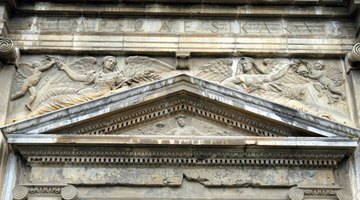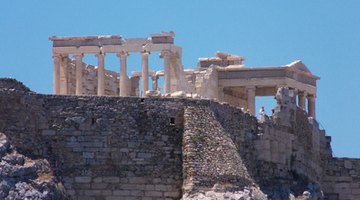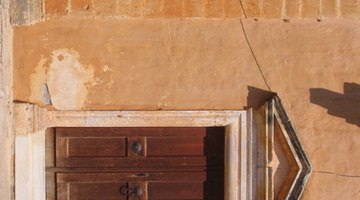What Is a Pediment?
Table of Contents
A pediment is an ornamental triangle formed by a typically low-pitched gabled roof, used to adorn a building's main entrance. The triangular area may be plain, but is often filled with design detail and even sculpture. Pediments are traditionally considered exterior building features, but also have been used inside.

Pediments are typically considered a feature of classical architecture.
Pediment or Portico?

A portico is another common architectural feature that is sometimes confused with a pediment. A portico is a covered entry-like a porch that juts out from the building and is supported by columns. The portico is considered to be pedimented if it contains a pediment on its gabled roof. Porticos may be square, rectangular and even circular. One of the most famous examples of a portico is the front entrance of the White House in Washington, D.C.
History

Pediments, used by early Greek architects, are associated with an architectural style known as Greek Temple. Pediments originally were used on temples honoring the Greek gods to symbolize the power of the gods over the people. Pediments also were used by the Romans and later by monarchs and the Catholic Church. Associated with divine providence, the form became popular in the United States during the Greek Revival period when Thomas Jefferson favored that style.
Examples

The Greek Parthenon and Pandroseion on the Acropolis are among the earliest and best-known examples of pediments. In the United States, the pediment and the associated columns and half-columns, known as pilasters, are often seen on government buildings, churches and courthouses. One of the most famous pediments is the Apotheosis of Democracy located on the east entrance of the White House, which features an array of symbolic sculptures carved inside the pediment.
Variations

One of the most common variations on the pediment is called a broken pediment, or an open pediment, in which the peak of the triangle is left open. A small pediment located over a window or a minor entrance door is often referred to as frontal. The use and design of pediments vary by architectural style.
Styles

Pediments are common in Greek Revival architecture and Georgian architecture, but examples of pediments can be found in many architectural styles throughout the world. Pediments may be grand or plain, but the triangular adornment often connotes a more formal aspect to a building.
References
Resources
Writer Bio
Jill Anje has written professionally since 1990, specializing in farming and gardening topics. She has written extensively for newspapers, businesses and nonprofit organizations and has been published in "Woman's Day" and regional California magazines. Anje graduated from a Midwest liberal arts college with a Bachelor of Arts in literature and writing.
Photo Credits
- courthouse image by Michael Shake from Fotolia.com
- courthouse image by Michael Shake from Fotolia.com
- white house image by Ritu Jethani from Fotolia.com
- carlos_v-01 image by Paco Ayala from Fotolia.com
- Pandroseion on the Acropolis image by DocAcesRock from Fotolia.com
- inside a courthouse image by Empath from Fotolia.com
- mediterranean architecture image by Mirek Hejnicki from Fotolia.com
More Articles



